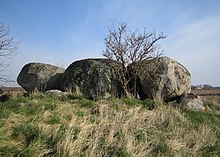Hagestad megalithic complexes
The Hagestad megalithic complex lies east of Ystad in the historic Swedish province of Skåne . Märta Strömberg examined the three passage graves : Albertshög (Hagestad No. 37), Carlshögen (Hagestad No. 14), Ramshög (also Ramsbjer, Hagestad No. 8) and the Dolmen ( Swedish Dosen , Hagestad No. 2) and published a joint report . The plants were built between 3500 and 2800 BC. BC as megalithic systems of the funnel beaker culture (TBK). Passage tombs are a form of Neolithic megalithic systems that consist of a chamber and a structurally separated, lateral passage. The form can be found primarily in Denmark, Germany and Scandinavia, as well as occasionally in France and the Netherlands. The megalithic systems of the funnel beaker culture emerged between 3500 and 2800 BC. Neolithic monuments are an expression of the culture and ideology of Neolithic societies. Their origin and function are considered to be the hallmarks of social development.
location
The study area of Märta Strömberg extended over an area of about 30 square kilometers in southeastern Skåne, between the cities of Ystad and Simrishamn . The four large stone graves and dolmens are located between Löderup and Hagestad in the municipality of Ystad .
Ramshög
The passage grave ( swedish gang handle ) was built on a natural hill. The interior dimensions of the chamber, made up of nine bearing stones and three cap stones, are approximately 5.2 × 2.6 m. The corridor has a width of 65 - 80 cm, a length of about 6.6 m and in the floor area has mostly evenly laid limestone slabs .
Digs
Incomplete excavations were carried out in 1875 by Baron A. Kurck. Strömberg also examined the immediate vicinity of the facilities. The small finds consisted mainly of amber , flint fragments, shards and burned bones. The forecourt of the facilities was also littered with soot particles . Ten undated hearths were excavated in Hagestad No. 2 .
The clay floor in Carlshögen was darkly discolored. Here, channels worked into the natural ground formed a Y-shaped pit, the arms of which end in front of the supporting stones. The width of the channels was about 35 cm, the depth up to 48 cm and the length up to 1.5 m. In the center was a depression of 60 cm with a diameter of 65 cm. In the three grooves, human bones were found in addition to piles of flint. Based on the 14 C dating from 2280 BC BC (uncalibrated) it is certain that the bones were brought in in close connection with the construction of the megalithic complex (around 3000 BC).
Strömberg also found pits in Ramshög. This was a trough-shaped depression that also contained datable human bone material. The bones, some of which are burnt here, come from two individuals. There were also flint chips, three flint knives and a ceramic shard. They are dated to 2530 BC. BC (uncalibrated) dated.
interpretation
There are different interpretations for the gutters and pits: "It could be skeletal parts from an earlier stage of the use of the grave", it could also be "skeletal parts that had previously been stored in another location (house of the dead or the like?)" or it could be “ human sacrifice ”. In the Y-pit of Carlshögen, fragmentary remains of eight people were found, in both graves no objects were found that would allow an alternative to the 14 C-method of dating. Strömberg sees parallels to the passage grave in Ingelstorp , Sweden in the systems of the two grave structures and suspects that the laying down was “directly related to the construction of the chamber”, as this happened before the flooring of flint and clay was laid.
See also
literature
- Karsten Kjer Michaelsen: Politics bog om Danmarks oldtid . Copenhagen 2002 ISBN 87-567-6458-8 , p. 251.
- Märta Strömberg : The megalithic tombs of Hagestad. On the problem of grave structures and grave rites . Acta Archaeologica Lundensia Volume 8. Bonn and Lund 1971.
Individual evidence
Web links
- Albertshög - entry in the database "Fornsök" des Riksantikvarieämbetet (Swedish)
- Carlshögen - entry in the database "Fornsök" des Riksantikvarieämbetet (Swedish)
- Ramshög - entry in the database "Fornsök" des Riksantikvarieämbetet (Swedish)
- Dolmen near Löderup - entry in the database "Fornsök" des Riksantikvarieämbetet (Swedish)
- The large stone grave "Ramshög" near Hagestad
Coordinates: 55 ° 24 ′ 27 ″ N , 14 ° 10 ′ 4 ″ E


